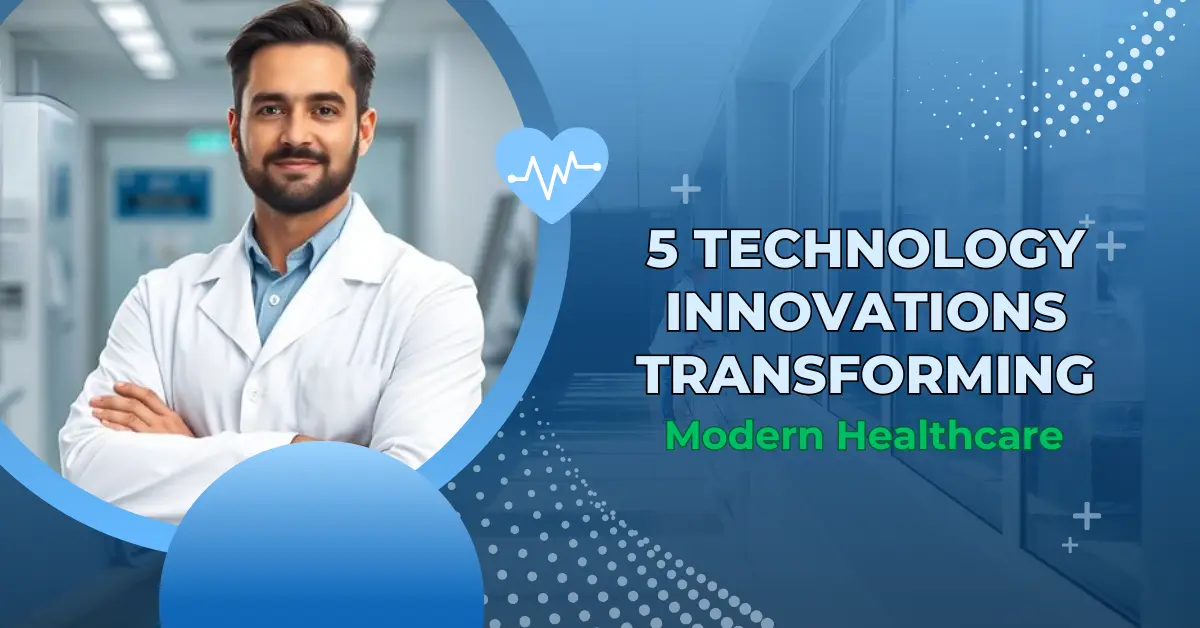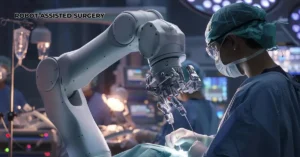
5 Technology Innovations Transforming Modern Healthcare
- 90
- 0
- 0
Modern Healthcare
Technology is changing healthcare, making it faster, smarter, and more efficient. From AI-powered diagnostics to telemedicine, innovations are helping doctors provide better care. Wearable devices track health in real-time, allowing early detection of problems. Robotic surgeries improve precision, reducing recovery time. 3D printing creates custom medical implants and prosthetics, making treatments more effective. Electronic health records make patient data easily accessible, improving diagnosis and treatment plans. These innovations save lives, reduce hospital visits, and make healthcare more accessible, especially in remote areas. With continuous advancements, healthcare is becoming more patient-friendly and efficient. As technology grows, it will further improve treatments, lower costs, and help people lead healthier lives. Tech-driven healthcare is the future, ensuring better medical care for everyone.
5 Technology Innovations Transforming Modern Healthcare
Healthcare continues to evolve with new technologies making medical care better, faster, and more accessible. Let’s look at 5 major technological advances that are changing how healthcare works today.
Artificial Intelligence in Medical Diagnosis

AI technology has become a powerful tool for doctors and healthcare providers. AI systems can now analyze medical images like X-rays, MRIs, and CT scans with remarkable accuracy. These systems help doctors spot potential issues that might be missed by human eyes alone.
For example, AI programs can detect early signs of breast cancer in mammograms or identify potential stroke risks in brain scans. This doesn’t replace doctors – instead, it gives them an extra set of eyes and helps them make better decisions. The technology processes thousands of images quickly, letting doctors focus more time on patient care.
Some hospitals now use AI to predict which patients might need urgent care based on their vital signs and medical history. This helps medical teams act faster and prevent complications before they become serious. The technology also helps reduce medical errors by double-checking diagnoses and treatment plans.
Telemedicine and Virtual Healthcare

The rise of telemedicine has made healthcare more convenient and accessible. Patients can now talk to their doctors through video calls from home, saving time and making it easier to get medical advice. This is especially helpful for people who live far from medical facilities or have difficulty travelling.
Virtual healthcare isn’t just about video calls. Patients can now:
- Send photos of skin conditions to dermatologists
- Get prescription refills through mobile apps
- Have regular check-ups with their mental health providers online
- Monitor chronic conditions without frequent hospital visits
Many insurance companies now cover telemedicine visits, making it a practical option for routine care. While some medical issues still need in-person visits, virtual care helps manage many health concerns effectively.
Wearable Health Technology

Smartwatches and fitness trackers have grown into powerful health-monitoring tools. These devices now track:
- Heart rate and rhythm
- Sleep patterns
- Blood oxygen levels
- Physical activity
- Stress levels
The data from these devices helps both patients and doctors understand health patterns better. For instance, someone with heart problems can share their heart rhythm data with their doctor, helping spot potential issues early. Diabetic patients can use continuous glucose monitors that connect to their phones, making it easier to manage their condition.
These devices also encourage people to take better care of their health by showing them real-time data about their activity levels and vital signs. Many can even detect falls and send automatic alerts to emergency contacts, which is particularly valuable for older adults.
3D Printing in Medicine

3D printing technology is changing how we approach medical treatment and surgery. Doctors can now create exact replicas of patients’ organs to practice complex surgeries before performing them. This helps reduce risks and improves surgical outcomes.
The technology is also revolutionizing prosthetics. Custom-made artificial limbs can be 3D printed at lower costs, making them more accessible to people who need them. These prosthetics fit better and work more naturally because they’re made specifically for each person.
Other uses of 3D printing in healthcare include:
- Dental implants and orthodontic devices
- Custom hearing aids
- Medical tools and instruments
- Models for medical training
- Artificial joints
Scientists are even working on printing living tissue, which could one day help create replacement organs for transplants.
Robot-Assisted Surgery

Surgical robots have become more common in operating rooms worldwide. These machines help surgeons perform precise movements during complex procedures. The most well-known surgical robot system lets doctors control robotic arms while watching a high-definition 3D view of the surgical site.
Benefits of robot-assisted surgery include:
- Smaller incisions, which mean less pain and faster healing
- Better precision during delicate procedures
- Reduced blood loss during surgery
- Shorter hospital stays for patients
- Less strain on surgeons during long operations
While robots don’t perform surgery on their own – they’re always controlled by skilled surgeons – they make certain procedures safer and more effective.
The Future of Healthcare Technology
These innovations show how technology continues to improve medical care. As these tools become more advanced and widespread, we can expect:
- Better early detection of diseases
- More personalized treatment plans
- Easier access to healthcare services
- Lower costs for certain medical procedures
- Improved patient outcomes
Healthcare providers are working to balance these new technologies with personal care. While machines and AI help with many tasks, the human touch in healthcare remains essential. Doctors and nurses use these tools to provide better care while maintaining meaningful connections with their patients.
Conclusion
Remember that these technologies keep improving. Today’s innovations will likely seem basic compared to what we’ll see in the coming years. The key is using technology to make healthcare better, more accessible, and more effective for everyone.
By staying informed about these advances, patients can better understand their healthcare options and work with their medical providers to get the best possible care. As technology continues to develop, we can look forward to even more improvements in how we prevent, diagnose, and treat health conditions.
FAQs
How is AI improving healthcare?
AI helps doctors diagnose diseases faster, predicts health risks, and assists in medical research. It also powers chatbots, health tracking apps, and robotic surgeries, making healthcare more efficient and accessible for everyone.
What role do wearable devices play in healthcare?
Wearable devices track heart rate, sleep, and physical activity. They help detect health issues early, provide real-time health monitoring, and encourage healthier lifestyles by offering personalized fitness and wellness recommendations.
How does telemedicine benefit patients?
Telemedicine allows patients to consult doctors remotely, reducing travel time and costs. It improves healthcare access, provides instant medical advice, and ensures timely treatment, especially for people in remote or underserved areas.
Can robots assist in surgeries?
Yes, robotic-assisted surgeries increase precision, reduce recovery time, and minimize complications. Surgeons use AI-powered robotic systems for delicate procedures, ensuring better accuracy and improved patient outcomes in complex surgeries.
How is 3D printing transforming healthcare?
3D printing creates customized prosthetics, medical implants, and even organ models for surgical planning. It reduces costs, improves patient care, and accelerates the development of innovative medical treatments and devices.
Also Read:
How AI Makes Your Daily Life Better: 5 Common Applications
References:
https://en.wikipedia.org/wiki/Health_technology
https://en.wikipedia.org/wiki/Artificial_intelligence_in_healthcare
https://pmc.ncbi.nlm.nih.gov/articles/PMC4147743/
Disclaimer: This blog is for informational purposes only. Healthcare technologies are constantly evolving, and their effectiveness may vary. Always consult medical professionals before relying on AI, telemedicine, or wearable devices for health decisions. We are not responsible for individual outcomes.
Related post



